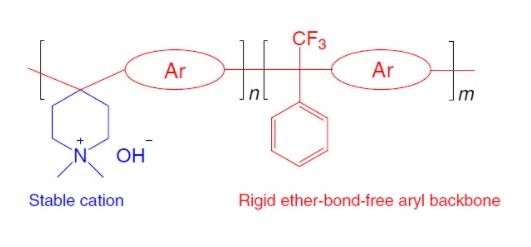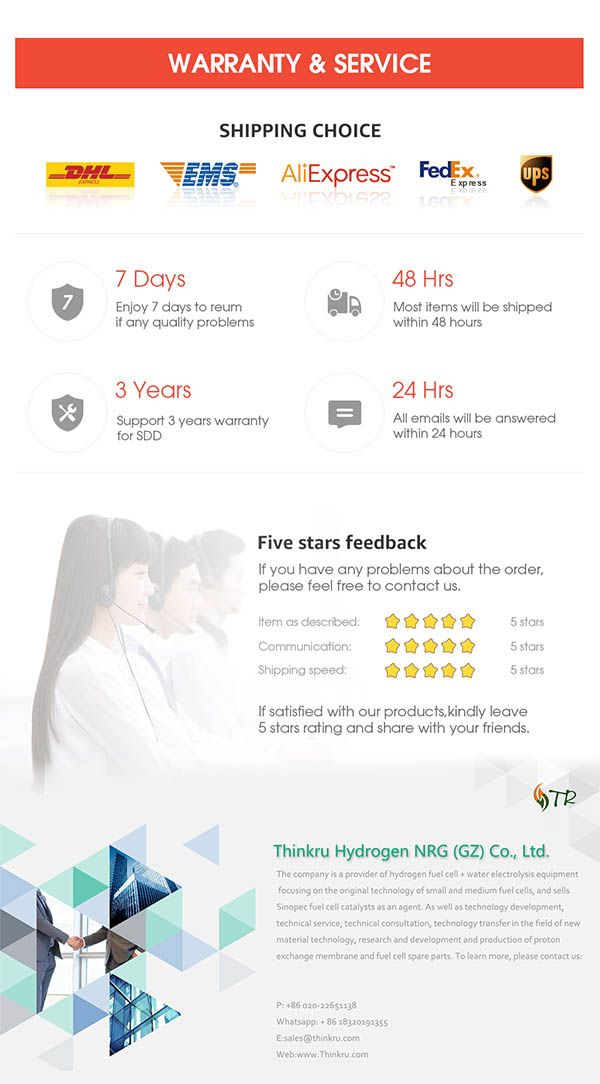Specification
20μm Anion Exchange Membrane
Thickness
20μm
lonic Form and Type
Anionic(Bicarbonate)
Basis Weight
~22.6g/㎡
Tensile Strength
>30MPa
Young's Modulus
>30
Elongation at Break (%)
>20
Specific Gravity
~1.13
lon Exchange Capacity
~2.35meq/g
Conductivity
~150 mS/cm(OH-form at 80 deg C)
Swelling Ratio
8%(at 80 deg C in 1M KOH)
Water Uptake
50%(at 80 deg C in 1M KOH)
AEMs are manufactured solely from the functionalized poly(aryl piperidinium) resin material and there is no mechanical reinforcement in them.Having the entire membrane manufactured from 100% resin material makes this membrane category to have higher ionic conductivity compared to mechanically reinforced AEM counterparts. In terms of mechanical robustness, mechanically reinforced AEMs would provide higher performance compared to AEM counterparts. AEMs are manufactured from the functionalized poly(aryl piperidinium) polymer. The general chemical structure of the poly(aryl piperidinium) resin material is provided below.

Benefits of AEMs:
-Non-reinforced and high anionic conductivity-Excellent chemical stability in caustic and acidic environments (pH range of 1-14)-Ultra-thin membranes with superb performance for various alkaline fuel cell, alkaline electrolyzer, direct ammonia fuel cells, and other relevant electrochemical technologiesl

*Some of the important properties of membranes are provided in the table are for reference and example purposes only.
Pre-treatment protocol:
AEM are shipped in the non-hydroxide form (more specifically in the bicarbonate form) and the proper pretreatment protocol needs to be followed in order tol convert it to the desired anionic form.
For standard alkaline fuel cell /electrolysis applications:
Allow the membrane to sit at ambient conditions for 1 hr without a cover sheet before use.
For hydroxide exchange membrane fuel cell or hydroxide exchange electrolysis applications or any other application that requires the hydroxide ion transfer across thel membrane, the membrane should be converted from bicarbonate form into OH- form for optimal conductivity.
To convert the membrane to OH- form, place the membrane in an aqueous solution of 0.5 M NaOH or KOH for 1 h at room temperature. After 1 h, replace the solution with fresh 0.5 M NaOH or KOH and allow the membrane to soak for 1 h at room temperature again. After the two soaks, rinse the membrane with DI water (pH - 7).
Minimizel exposure to ambient air, as the CO2 can exchange back into the membrane causing the membrane to convert back to bicarbonate form. The reaction between CO2 andl hydroxide ions is purely chemical and it will readily happen if the OH- form of the membrane is exposed to an environment that has CO2 (such as ambient air, etc.). This conversion can be completely eliminated by simply doing the conversion and testing in a CO2-free drybox environment.
For electrochemical reduction of CO2 or CO or in CO2 electrolysis applications:
Allow the membrane to sit at ambient conditions for 1 hr without a cover sheet before use.
The membrane is shipped in the bicarbonate form. If you are working with bicarbonate electrolytes in your setup, then there is no need to pretreat the membranel and it can be used in the as received form.
If you are working with carbonate electrolytes, then the Piperlon membrane needs to be converted to carbonate form.

Name: Bekah Zeng
Mobile:+86 18122128824
Whatsapp:+86 18122128824
Email:Bekah@thinkru.com
Name: Stella Luo
Mobile:+86-15013165672
Whatsapp:+86-15013165672
Email:stella@thinkru.com
Name: Sally He
Mobile:+86-15626431755
Whatsapp:+86-15626431755
Email:sally.he@thinkru.com
Add:2203, Building 12, No.400 Xincheng Avenue, Zengcheng District, Guangzhou City, China